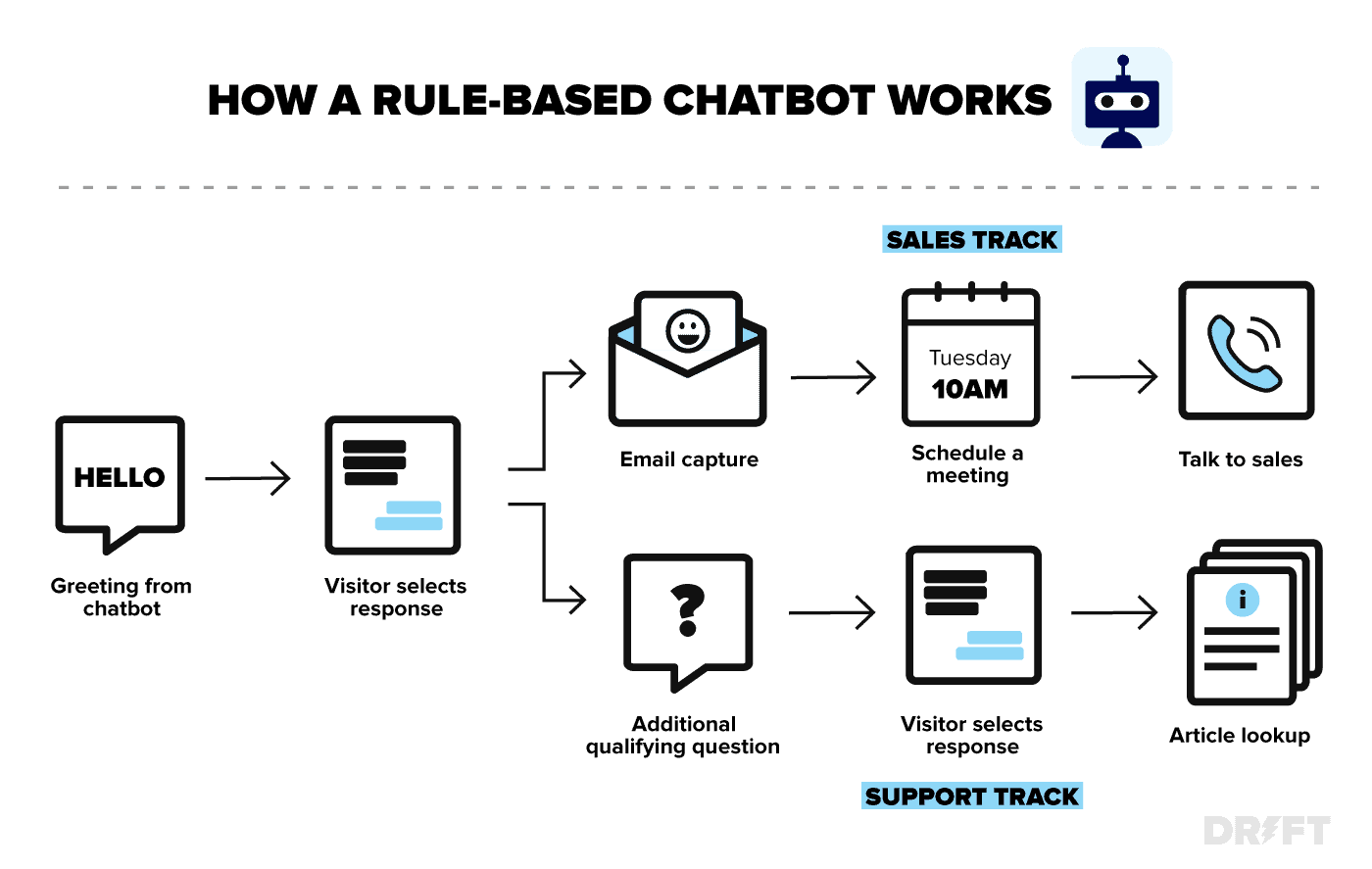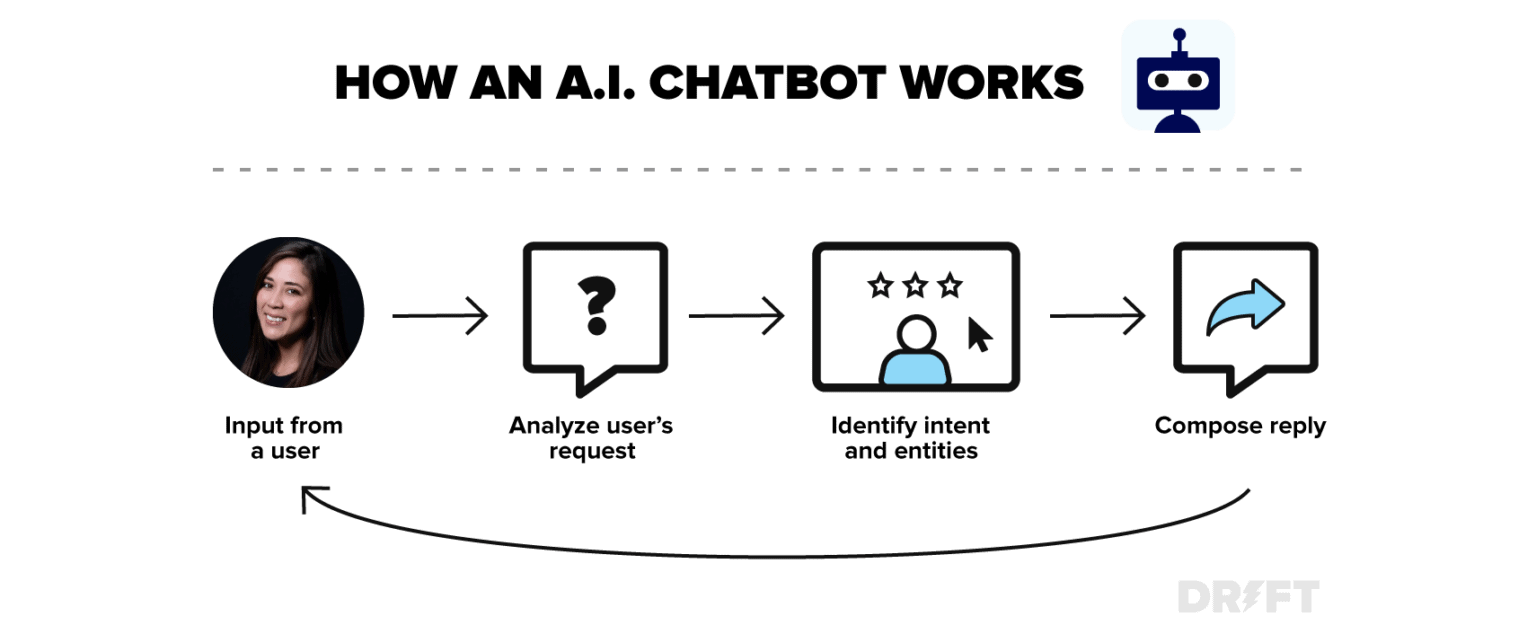What is a Chatbot? The Ultimate Guide
Learn about chatbots: what they are, how they work, types of chatbots, how businesses use them, & see examples of great chatbots.
Chatbots are software applications that simulate human conversation. They follow a set of pre-designed rules to mimic real-life interactions and answer customer questions. In addition, chatbots that use artificial intelligence (AI) and natural language processing (NLP) can analyze these customer interactions at an almost human level.
With chatbots, you can instantly engage website visitors with specific pre-programmed messages tailored to each visitor. You can also build specific chatbots for each website page or target audience based on who they are, where they came from, what content they are engaging with, and what stage of the buying journey they are in.
How do chatbots work?
Chatbots process the data provided by the site visitor to generate the right response. They help answer questions and offer next steps, such as scheduling a demo, booking a call, or making a purchase. Best of all, they’re active 24/7, whether your sales team is online or not.
In short, a well-designed chatbot will:
- Use existing conversation data to understand the type of questions people ask.
- Analyze correct answers to those questions
- Use machine learning and NLP to learn context from previous interactions, and continually get better at answering those questions.
Why were chatbots created and why are they important?
Chatbots were created to help alleviate pain points customers frequently bumped into in their online buying experience. And they are especially important now, given how much B2B buying happens online. Today, buyers prefer to research products and services on their own time, and they also expect companies to deliver accurate and relevant responses at lightning-fast speeds.
- In 2021, buyer frustration with accessing basic business information grew by 20%.
- Buyer expectations for quick, personalized experiences have grown by 26% since 2020.
- The demand for immediate responses grew in almost every conversation category by 64% year-over-year.
As buying journeys grow more complex, removing friction from the digital experience is essential. Chatbot technology enhances the buyer and customer experience by providing a channel for site visitors to interact with brands 24/7 without the need for human intervention.
With the help of this technology, companies can rise to meet the expectation of a personalized, always-on experience. And only companies that do so will succeed in differentiating themselves from their competitors and becoming leaders in their markets.
Types of chatbots
One of the most interesting things about chatbot software is the variety of virtual assistants out there. There are three types that most consumers see today:
1. Rule-based chatbots: Rule-based chatbots map out conversations through predetermined rules and respond to specific pre-defined options or keywords. This allows them to guide the conversation based on the site visitor’s inputs.

Keep in mind, though, that a rule-based chatbot is limited to its pre-determined rules. So it can only act or respond to things that have been anticipated.
2. AI chatbots: Unlike rule-based, artificial intelligence chatbots are trained to analyze and understand a site visitor’s intent, then deliver the answer they think is best based on existing data.
 With a Conversational AI platform, you can give site visitors the freedom to guide the conversation in their own words so they can instantly get the information they need, access relevant resources, and resolve issues on their own — without any human intervention. What’s more, these chatbots continue to learn and refine their responses as they collect more and more conversational data.
With a Conversational AI platform, you can give site visitors the freedom to guide the conversation in their own words so they can instantly get the information they need, access relevant resources, and resolve issues on their own — without any human intervention. What’s more, these chatbots continue to learn and refine their responses as they collect more and more conversational data.3. Live chat This communication channel is primarily used by sales and sales development teams to connect with site visitors for real-time, human-to-human conversations. Customer support organizations also use live chat software to answer questions in real time.
As you can see, the way these virtual assistants work varies quite a bit — and they help your business in different ways. For example, an AI chatbot can automatically qualify site visitors to help your sales team pinpoint high-intent conversations, whereas a live chat solution provides a space for your team to directly connect with and better serve your customers. Ultimately, what solution you choose to use will depend on the goals you have.
What are the benefits of chatbots?
With buyers wanting more personalized experiences, forward-thinking brands have to find new ways to go beyond customer expectations.
While this can be done with human beings, there is a tipping point. That’s why brands have adopted chatbots to help them take advantage of the following benefits:
- Increase website engagement with personalization: There’s no better time to start a conversation than when a buyer is exploring your website. This technology engages with site visitors at the moment of highest intent through personalized conversations.
- Leverage visitor intelligence for better conversations: With visitor intelligence, chatbots can identify site visitors and deliver an experience tailored to them. They also take in additional information from the visitor and build them into future conversations.
- Give high-value accounts the red carpet experience: You’ll never miss an opportunity to engage a target account again — not with a chatbot that personally greets the buyer and gives them a fast track to sales. Plus, with this technology in place, you won’t have to worry about losing valuable opportunities when your sales team is offline.
- Prioritize customer prospecting with real-time notifications: You only want to chat with those accounts that are ready to buy. Streamline your prospecting by notifying sales reps when a high-intent, priority account is on your website so they can jump straight into chat and human interaction.
- Generate more qualified leads: It would be nice if we could talk to every lead and ensure they’re a good fit before scheduling a meeting. But that’s impossible to do at scale. Chatbots can do most of the heavy lifting by qualifying your leads in real time and improving sales acceleration.
- Combat customer churn: This technology is the perfect solution to high-volume support inquiries. Instead of forcing customers to navigate cluttered knowledge bases, you can use a customer service chatbot to deliver support information instantly, 24/7.
- Chat live when needed: Sometimes customers just need human support. Customer service bots will automatically route in your team for high-level customer issues without distracting them with easily-answered questions.
- Increase lead to pipeline conversion rates by up to 100%: We commissioned Forrester Consulting to conduct a Total Economic ImpactTM (TEI) study to examine the potential return on investment (ROI) of Drift. The report found that companies using Drift can grow annual recurring revenue (ARR) in target accounts by up to 17.5% and experience up to a 670% ROI. That’s a lot of impact on pipeline.
What are common challenges?
In an ever-evolving digital landscape, there will inevitably be bumps in the road. While chatbots greatly improve the buying experience, they’re not perfect.
Some of the potential challenges include:
- Misinterpreting messages: Chatbots can have difficulty understanding the variety of ways in which people talk — such as slang, misspelled words, and the nuances of certain sentences — which can lead to misunderstandings.
- Not recognizing visitors: Without integrated intel, your bots might end up asking your visitors (even your top accounts) a bunch of qualifying questions. And then your sales reps may be forced to repeat those same questions on a call.
- Missing key opportunities: While a chatbot offers a great experience for the majority of your site visitors, they’re not ideal for your target accounts. You’ll want to use one with strong routing rules and real-time notifications so those accounts are connected with a sales rep right away.
- Limited conversation options: Most chatbots (with the exception of AI-powered chatbots) offer only a few responses for the site visitor to choose from. So there’s a good chance your visitors will not find what they are looking for or they may have to navigate a maze of chat options to get there.
- Lacking personalization: Today’s buyers consider personalized experiences the norm. However, some bots fail to leverage real-time personalization, without which the buying experience feels impersonal and robotic.
- Need to be maintained: The ideal buying experience is always changing — and that means your chatbots have to keep pace. No matter what kind of bot you use, you have to optimize them regularly to ensure buyer and customer satisfaction. They’re not a tool you can set and forget.
Today’s chatbots are constantly evolving and improving — but it’s hard to predict what challenges may crop up in the future.
The good news is a lot of the challenges that we’ve listed here can be solved with Drift Conversational Sales which offers custom and AI-enabled chatbots that follow best practices, such as having built-in intelligence tools, sending real-time notifications, and more.
The ultimate chatbot example library
So you might be thinking: What does this look like in action?
To give you an idea, we’ve assembled examples that showcase different playbooks at different stages of the buying journey. You’ll see examples from B2B, B2C, and everything in between.
1. Brandwatch: Contact us
Brandwatch’s Contact Us chatbot offers site visitors the chance to skip the form and connect with a human right then and there.
2. PTC: Persona targeting
PTC’s Persona Targeting chatbot homes in on the visitor’s specific industry by offering them the chance to speak with an industry expert.
3. Lessonly: Conversational content
Lessonly’s Conversational Content chatbot pops up alongside a piece of content so the visitor can ask questions while browsing — or even schedule a call with sales.
4. Zenefits: Website concierge
Zenefits’ Website Concierge is an AI-enabled chatbot that allows site visitors to dive into their needs and interests by typing straight into chat.





























